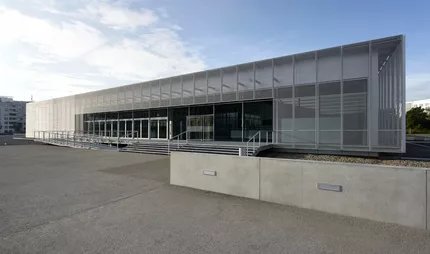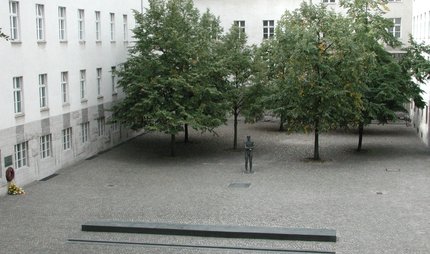
Jüdisches Museum (Jewish Museum Berlin)
Radical concepts
The Jewish Museum Berlin brings you closer to German-Jewish culture and history in an unusual architectural setting. The permanent exhibition ‘Jewish History and Present in Germany’, covering more than 3,500 square metres, is free of charge for all visitors.
Visitors can follow the history of the Jews in Germany from the Middle Ages to the present day in a multimedia and interactive way and gain insights into the diversity of Jewish culture. The axes in the basement of the Libeskind Building with the Garden of Exile and the installation "Fallen Leaves" by Menashe Kadishmann in the Void of Remembrance are impressive examples.


Experience, perceive and reflect - the Jewish Museum in Berlin tells you the story of Jewish culture in Germany. When you visit the museum, you will find yourself in the centre of a total work of art. The entire architecture (inside and out) symbolises this ambivalent theme. Architect Daniel Libeskind designed the museum building in a zigzag shape that looks like a lightning bolt or a broken Star of David. Empty spaces, known as voids, run through the building. These cold, unlit concrete shafts are not accessible except for the Memory Void. They allow visitors to physically experience the emptiness created by the Holocaust.
The museum, a work of art in itself
The museum building itself is extraordinary. The building complex is constructed in a zigzag shape with sharp angles. The façade is clad in brightly coloured titanium and zinc. You enter the museum itself via the old Kollegienhaus from the 18th century.
This is where the entrance area of the Jewish Museum is located today. Here you will also find the Glashof, a roofed inner courtyard that opened in 2007 and serves as a lounge area. The light-flooded space is spanned by white steel structures reminiscent of branches. The reflections of the glass panes and the shadows of the steel trees create an aesthetically pleasing space. The atrium is intended to evoke the Jewish Festival of Tabernacles and Thanksgiving, Sukkot, which celebrates the crossing of the desert by the Israelites.
The entrance takes you to the basement of the Libeskind building. Here you will encounter three axes, highly symbolic corridors that symbolise phases of Jewish life in Germany: Exile, Holocaust and Continuity. If you take the axis of exile, you come to the Garden of Exile. Concrete steles and the sloping ground create a feeling of uncertainty. Here, olive trees symbolise confidence even in times of hardship.
The Axis of the Holocaust leads you to a dark tower. A bare concrete shaft with a narrow slit of light symbolises hopelessness and abandonment.
The Jewish Museum as a place of Berlin Modernism
When commissioned, Daniel Libeskind was faced with a difficult question: how can a museum do justice to Jewish history in Germany? With his architecture, he aimed to make the museum building an important part of the museum experience. The Jewish Museum in Berlin turns a visit into a physical experience.
Disorientation, breaking with museum conventions, deliberate inconsistencies that make you think. Libeskind uses these means to force visitors to engage with his building and thus with the history of Jews in Germany exhibited there.
One of the most important elements here are the aforementioned Voids that run through the entire building. As empty, inaccessible spaces, they serve no purpose but instead fulfil an important psychological function.
Like many of Libeskind's other designs, the Jewish Museum is considered a deconstructivist building. The architecture of deconstructivism is all about dismantling parts of buildings and reassembling them in a new form. The buildings are not solid, but reveal their instability. Although Libeskind does not see himself as a deconstructivist, the Jewish Museum is one of the most impressive buildings of this architectural style.

Special exhibits at the Jewish Museum Berlin
- Shalechet (fallen leaves): Thousands of faces moulded from iron on the floor of a void
- The Torah as the central exhibit in the first exhibition room
- Sound Room: from the sound of the shofar to Israeli pop music
- Installation DRUMMERRSSS by Gilad Ratman
Guided tours at the Jewish Museum Berlin
General public tours take place every Saturday at 3 pm and every Sunday at 11 am
Other memorials to National Socialism in Berlin
In Berlin, there are numerous places of remembrance of the Holocaust and the National Socialist era:
- The Documentation Centre Topography of Terror is located on the site where the SS once had its headquarters. It deals with the terror between 1933 and 1945. After one kilometre to the north, you come to the Memorial to the Murdered Jews of Europe. Here, concrete blocks of different sizes are arranged in an undulating pattern. You walk through it like a labyrinth.
- The House of the Wannsee Conference is also an important place of remembrance. This is where the National Socialists planned the genocide of the European Jews. Among other things, it provides information about the deportation to Eastern Europe in a media centre. The T4 - Memorial and Information Centre for the victims of the National Socialist "euthanasia" murders sets a different accent: more than 70,000 disabled people were killed in the T4 campaign during the Second World War. "T4" stands for Tiergartenstraße 4, the official residence of the perpetrators. The memorial commemorates this chapter with information about the victims.
Just a few metres away on Stauffenbergstraße is the Bendlerblock, today the second seat of the Ministry of Defence. The German Resistance Memorial with a courtyard of honour for the resistance fighters around Stauffenberg is located here.
How to get there
The easiest way to get to the Jewish Museum Berlin is by underground. Take the U6 line to Kochstraße. Then it's about a ten-minute walk. The M29, M41 and 248 buses also stop nearby. With the Berlin WelcomeCard you get a 25% discount on admission to the exhibitions. Admission to the large permanent exhibition is free. With the purchase of the Museumspass Berlin you can visit the entire museum for free on three consecutive days. Persons under the age of 18 receive free admission.
So-called "hosts" are available in the museum to help you find your way around. You can recognise them by their red scarves. There are regular public tours of the Jewish Museum, which you can book online in advance. School classes and groups can book guided tours on a specific topic. There are special workshops for children that convey sensitive topics in a child-friendly way.
Opening hours
| Monday | |
|---|---|
| Tuesday | |
| Wednesday | |
| Thursday | |
| Friday | |
| Saturday | |
| Sunday |



